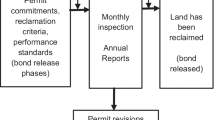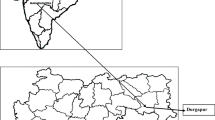Abstract
Eco-restoration of mine overburden (OB) or abandoned mine sites is a major environmental concern. In the present investigation, an integrated approach was used to rejuvenate a high-sulphur mine OB dumping site in the Tirap Collieries, Assam, India, which is situated in the Indo-Burma mega-biodiversity hotspot. A mine OB is devoid of true soil character with poor macro and micronutrient content and contains elevated concentrations of trace and heavy metals. Planting of herbs, shrubs, cover crops and tree species at close proximity leads to primary and secondary sere state succession within a period of 3 to 5 years. A variety of plant species were screened for potential use in restoration: herbs, including Sccharum spontaneum, Cymbopogon winterianus Jowitt (citronella), and Cymbopogon flexuosus (lemon grass) cover plants, including Mimosa strigillosa, M. striata, and M. pigra; shrubs, including Sesbania rostrata (dhaincha) and Cassia streata (cassia); and tree species, including Gmelina arborea (gomari) and Dalbergia sissoo (sissoo). Amendment with unmined soil and bio-organic matter was required for primary establishment of some plant species. Management of these plant species at the site will ensure long term sustainable eco-restoration of the coal mine-degraded land.
Similar content being viewed by others
References
Akala B 1995 North Eastern coalfields — some highlights; J. Mines, Metals and Fuels 43(9–10) 303–305.
Alexander M 1965 Most probable number methods for microbial population, In: Methods for soil analysis 2 (ed.) Black C A, Che. Micro. Pro. 1 462–472.
Almas A R, Bakken L R and Mulder J 2004 Changes in tolerance of soil microbial communities in Zn and Cd contaminated soils; Soil Biol. Bioch. 36 805–813.
Anderson J P E and Domsch K H 1990 Application of ecophysiologocal quotients (QCO2 and Dissolved Oxygen) on microbial biomass from soil of different cropping histories; Soil Biol. Bioche. 25 393–395.
Bezbarua B, Saikia N and Bora T 1995 Effect of pesticides on most probable number of soil microbes from tea (Camellia sinensis) plantation and uncultivated land enumerated in enrichment media; Ind. J. Agr. Sci. 65(8) 578–583.
Camina F, Trasar-Cepeda C, Gil-Sotres F and Leiros M C 1998 Measuring of dehydrogenase activity in acid soils rich in organic matter; Soil Biol. Bioche. 30 1005–1011.
Chaoji V 2002 Environmental challenges and the future of Indian coal; J. Mines, Metals and Fuels 11 257–262.
Cherfas J 1992 Trees help nature reclaim the slag heaps; New Sci. 14–15 24–29.
Cunningham S D and Berti W R 1993 The remediation of contaminated soils with green plants: An overview; In: Vitro Cell. Deve. Biol., J. Tissue Cult. Assoc. 29 207–212.
Cunningham S D and Ow DW 1996 Promises and prospects for phytoremediation; Plant Phys. 110 715–719.
Deka Boruah H P 2006 North eastern coal and environment: An overview. Proc. on Characterization and Gainful Utilisation of NE Coal, Published by RRL, Jorhat, pp 28–33.
Deka Boruah H P, Rabha B K, Pathak N and Gogoi J 2008 Non-uniform patchy stomatal closure of a plant is a strong determinant of plant growth under stressful situation; Curr. Sci. 94 1310–1314.
Dobson A P, Bradshow A D and Baker A J M 1997 Hopes for the future: restoration ecology and conservation biology; Sci. 277 515–522.
Eamus D, Macinnis-Ng C M O, Hose G C, Zeppel M J B, Taylor D T and Murray B R 2005 Ecosystem services: An ecophysiological examination; Aust. J. Bot. 53 1–19.
Ernst W H O 1996 Availability of heavy metals and decontamination of soils by plants; App. Geol. J. Int. 11 163.
Ford K L and Walker M 2003 Abandoned mine waste repositories: sites selection, design and cost, Technical Note 410, Denver Bureau of Land Management.
Ghose M K 2004 Effect of opencast mining on soil fertility; J. Sci. Indust. Res. 63 1006–1009.
Gogoi J, Pathak N, Dowrah J and Deka Boruah H P 2007 In situ selection of tree species in environmental restoration of opencast coalmine wasteland; Proceedings of Int. Sem. on MPT 2007, Allied Publisher, pp 678–681.
Gonzalez R C and Gonzalez-Chavez M C A 2006 Metal accumulation in wild plants surrounding mining wastes: Soil and sediment remediation (SSR); Environ. Poll. 144 84–92.
Hariis J A, Hobbs R J, Higgs E and Aronson J 2006 Ecological restoration and global climate change; Rest. Ecol. 14 170–176.
Insam H and Domsch K H 1988 Relationship between soil organic carbon and microbial biomass on chronosequences of reclamation sites; Microb. Ecol. 15 177–188.
Jenkinson D, Brookes C P and Powlson D S 2004 Measuring soil microbial biomass; Soil Biol. Bioche. 36 5–7.
Juwarkar A A and Singh S K 2007 Utilisation of municipal solid waste as an amendment for reclamation of coal mine waste dump; Int. J. Environ. Tech. Manag. 7(3/4) 407–420.
Juwarkar A A and Jumbalkar H P 2008 Phytoremediation of coal mine spoil dump through integrated biotechnological approach; Biores. Technol. 99 4732–4741.
Kundu N K and Ghose M K 1994 Impact on soil quality due to opencast coal projects; In: Proceeding Second National Seminar on Minerals and Ecology. (ed.) Banerjee S P, Indian Schools of Mines, Dhanbad, Oxford and IBH Publishing, New Delhi.
Maiti S K 2007 Bioremediation of coalmine overburden dumps with special emphasis in micronutrients and heavy metals accumulation in tree species; Environ. Monit. Assess. 125 111–122.
Matson P A, Parton W J, Powere A G and Swift M J 1997 Agricultural intensification and Ecosystem properties; Sci. 277 504–509.
Mendez M O and Maier R M 2008 Phytostabilization of mine tailings in arid and semiarid environments — An emerging remediation technology; Environ. Health Prospect. 116 278–283.
Mishra K C 1992 Manual of Plant Ecology; Oxford IBH Publishing Co. Pvt. Ltd.
Pal B K 2003 Health and safety risk assessment in environmental management of mining operations; J. Mines, Metals and Fuels 51(7–8) 245–250.
Prasad M N V 2004 Phytoremadiation of metals in the environment for sustainable development; Proc. Nat. Acad. Sci. India 70 71–98.
Raju K S and Hassan M 2003 Role of Indian Bureau of Mines in protection of environment in the minerals sector; J. Mines, Metals and Fuels 51(6) 196–200.
Salt D E, Blaylock M, Kumar P B A N, Dushenkov V, Enseley D D, Chet I and Raskin I 1995 Phytoremediation: A novel strategy for removal of toxic metals from the environment using plants; Biotechnol. 13 468–474.
Schippers A, Jozsa P G, Sand W, Kovacs Z M and Jelea M 2000 Microbiological pyrite oxidation in a mine tailings heap and its relevance to the death of vegetation; Geomicrobiol. J. 17 151–162.
Sharma P D 1995 Ecology and Environment, Rastogi Publication, Meerut, India.
Singh R S, Chaulya S K, Tewary B K and Dhar B B 1996 Restoration of a coal-mine overburden dump — A case study; Coal Int. 244 83–88.
Skinner F A 1971 Isolation of soil consortia in Isolations of Anaerobes (eds) Chapton D A and Board R L, Technical Series 5 57–80.
Tabatabai M A and Bremner J M 1969 Use of p-nitrophenyl phosphate for essay of soil phosphatase activity; Soil Biol. Bioche. 1 301–317.
Tiwary R K 2001 Environmental impact of coal mining on water regime and its management; Water, air and Soil Pollution 132 185–199.
Vance C P 2000 An extraction method for measuring soil microbial biomass C; Plant Physiol. 127 390–397.
Wong M H 2003 Ecological restoration of mine degraded soils, with emphasis on metal contaminated soils; Chemosphere 50 775–780.
Author information
Authors and Affiliations
Corresponding author
Rights and permissions
About this article
Cite this article
Dowarah, J., Deka Boruah, H.P., Gogoi, J. et al. Eco-restoration of a high-sulphur coal mine overburden dumping site in northeast India: A case study. J Earth Syst Sci 118, 597–608 (2009). https://doi.org/10.1007/s12040-009-0042-5
Received:
Revised:
Accepted:
Published:
Issue Date:
DOI: https://doi.org/10.1007/s12040-009-0042-5




